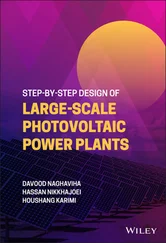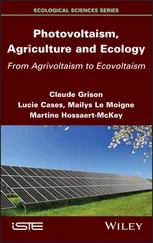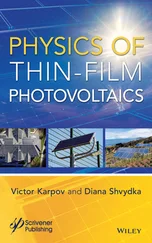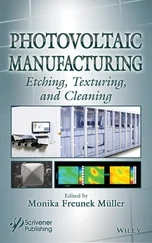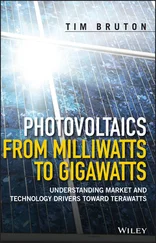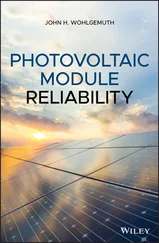As windows in most applications do not face the sky horizontally, the actual irradiance E will result from the incident power P received on an area A in an incident angle α following Eq. (3.1).
(3.1) 
In some applications, a sensor might be directly installed on a window facing the outdoors. However, most devices will be installed within a certain distance to the window. As the intensity is inverse to the square of the distance from the emitter, the incident irradiance is additionally lowered following Eq. (3.2)
(3.2) 
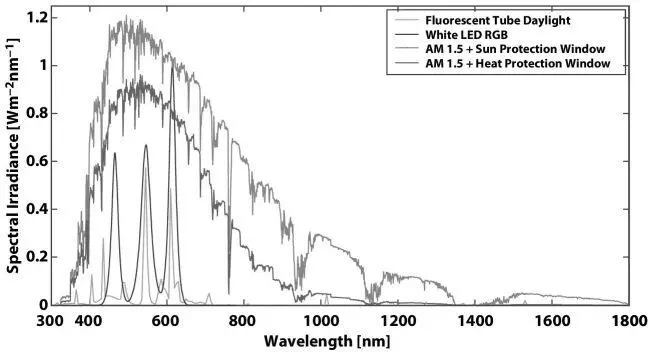
Figure 3.1Spectra for sunlight through heat and sun protection windows, LED, and warm white fluorescent lamps. The emissions after 1800 nm are negligible for this visualization purpose.
Note that the discussion so far has only included direct radiation. Indirect radiation resulting from reflection or transmission indoors has been neglected. Its effects and modeling are discussed in detail in Chapter 4.
The photovoltaic efficiency limit for a conversion from optical radiation to photoelectric power depends on many parameters. Some of these parameters are spectrally dependent, such as the energy gap or the photon flow, that is the intensity of the radiation. The number of photons N (λ) per area A and time t yields the spectral photon flux ϕ pλ
(3.3) 
The thermodynamic limit to photovoltaic efficiencies presented by Shockley and Queisser was calculated for black body radiation following Planck’s law [16]. It assumes that an ideal single absorber material, where every incident photon is absorbed, yields the so-called external quantum efficiency EQE = 1. Then the short circuit current density j sc≈ j ph, where the photocurrent density j phis
(3.4) 
with the elementary charge q = 1.602 10 -19As. The Shockley-Queisser limit can be applied numerically to spectral distributions [17, 27]. Figure 3.2 shows the resulting maximum photovoltaic efficiencies for different indoor spectra in comparison to the solar AM 1.5 spectrum.
All indoor radiation is optimized for its visibility by the recipient. For humans, this is the band between 380 nm and 780 nm. Any radiation beyond this narrow band is generally unused and thus lost. The maximum indoor efficiencies therefore are significantly higher than outdoor photovoltaic efficiencies. The radiation filtered in windows outside the visibility spectrum could also be used for photovoltaic conversion.
Resulting from the peak of the human visibility function, the ideal indoor photovoltaic material has a higher band gap than for outdoor applications. Indoor cells optimized to indoor solar radiation have ideal band gaps between 1.4 to 1.6 eV, whilst cells for current artificial light sources have ideal band gaps between 1.8 to 2 eV.
Detailed model and technology discussions for the most interesting indoor materials are provided in the following chapters of this book.
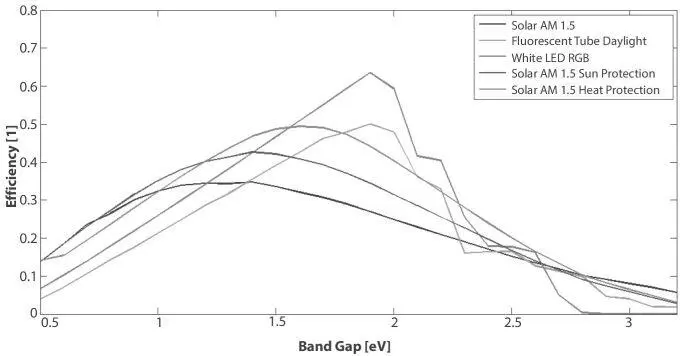
Figure 3.2Efficiencies for indoor spectra calculated following the Shockley-Queisser limit (adapted from [10]). As a reference, efficiency for outdoor AM 1.5 is given. Due to the adaption of functional window coatings to the human eye, the shift of the ideal band gap to higher values also holds true for indoor solar radiation.
3.3 State of IPV Design, Issues, Approaches
As the irradiance level in indoor surroundings generally is very low, the ratio of active conversion to loss area is very small. Thus, efficiency losses need to be avoided where possible. Therefore, a good indoor design avoids shading caused by module integration, ensures good electric contacts, and aims to avoid recombination losses at surfaces, including edges.
Another issue is a reliable characterization of the device. As standards and equipment are missing, reproducibility and comparability pose a challenge both to designers and customers. This is enforced by the fact that today’s most common light sources vary in their spectral distribution and that the available measurement instruments vary in their response to these light sources, too. Furthermore, photometric measurement devices optimized to measure human visibility exclude spectral radiation that is usable for IPV devices. These issues and approaches to solutions are outlined and discussed in Chapters 4and 5. Müller (Freunek) demonstrated the use of a radiometric reference cell and pyranometers for indoor applications [12, 14]. Today, Enlitech offers an indoor solar cell light simulator, which is capable of measuring both photometric illuminance and radiometric irradiance for low irradiance levels and narrow-band light sources such as LED [28].
Contrary to outdoor applications, where the geographic location and the azimuth might be sufficient for the first stage of planning, in IPV spectra, intensity and contribution of direct irradiance vary from application to application. As these measurements can become too elaborate for the first stage of product development, simulations can be alternatively used. Different research groups have evaluated this for indoor conditions [13, 14, 29, 30]. Chapter 4introduces the simulation of indoor irradiance conditions.
3.4 Fields of Application
Everywhere humans live and work, some kind of lighting optimized for the human eye is installed. Indoor photovoltaic devices can be operated with it, and often the available light is defined in its spectral range and irradiance following obligatory standards. This eases the design process. Although the classical and well-known IPV products include niche products such as kitchen scales, LED powered lamps, and solar calculators, the potential applications reliably realized with a proper IPV design are as varied as human life. The recent industrial takeoff of the Internet of Things (IoT) with billions of required sensor nodes in the field might drive a wide use of IPV. This section outlines the most common or important application fields for IPV today and in the near future.
3.4.1 Customer and Office Applications
Charging stations for mobile phones are common consumer IPV applications. Further examples include solar calculators, LED powered lamps such as the IKEA Sunnan lamp, USB chargers such as IXYS Green Energy products, and wireless keyboards such as the Logitech K750 [31, 32]. Figure 3.3 shows the Soehnle Easy Solar White kitchen scale.
However, regarding the size of the consumer market, the distribution of products powered by optical radiation is surprisingly low. Reasons for this might be found in spectrally mismatched design, resulting reliability issues, and standard mass production lines that are not optimized for low power consumption.
Читать дальше











